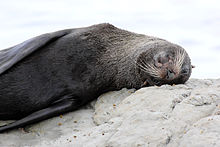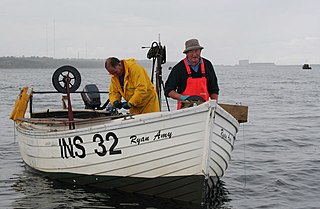
Longline fishing, or longlining, is a commercial fishing angling technique that uses a long main line with baited hooks attached at intervals via short branch lines called snoods or gangions. A snood is attached to the main line using a clip or swivel, with the hook at the other end. Longlines are classified mainly by where they are placed in the water column. This can be at the surface or at the bottom. Lines can also be set by means of an anchor, or left to drift. Hundreds or even thousands of baited hooks can hang from a single line. This can lead to many deaths of different marine species. Longliners – fishing vessels rigged for longlining – commonly target swordfish, tuna, halibut, sablefish and many other species.

Bycatch, in the fishing industry, is a fish or other marine species that is caught unintentionally while fishing for specific species or sizes of wildlife. Bycatch is either the wrong species, the wrong sex, or is undersized or juveniles of the target species. The term "bycatch" is also sometimes used for untargeted catch in other forms of animal harvesting or collecting. Non-marine species that are caught but regarded as generally "undesirable" are referred to as "rough fish" and "coarse fish".

The pantropical spotted dolphin is a species of dolphin found in all the world's temperate and tropical oceans. The species was beginning to come under threat due to the killing of millions of individuals in tuna purse seines. In the 1980s, the rise of "dolphin-friendly" tuna capture methods saved millions of the species in the eastern Pacific Ocean and it is now one of the most abundant dolphin species in the world.

The yellowfin tuna is a species of tuna found in pelagic waters of tropical and subtropical oceans worldwide.
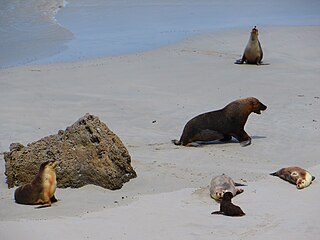
The Australian sea lion, also known as the Australian sea-lion or Australian sealion, is a species of sea lion that is the only endemic pinniped in Australia. It is currently monotypic in the genus Neophoca, with the extinct Pleistocene New Zealand sea lion Neophoca palatina the only known congener. With a population estimated at around 14,730 animals, the Wildlife Conservation Act of Western Australia (1950) has listed them as “in need of special protection”. Their Conservation status is listed as endangered. These pinnipeds are specifically known for their abnormal breeding cycles, which are varied between a 5-month breeding cycle and a 17-18 month aseasonal breeding cycle, compared to other pinnipeds which fit into a 12-month reproductive cycle. Females are either silver or fawn with a cream underbelly and males are dark brown with a yellow mane and are bigger than the females.

Arctocephalus forsteri is a species of fur seal found mainly around southern Australia and New Zealand. The name New Zealand fur seal is used by English speakers in New Zealand; kekeno is used in the Māori language. As of 2014, the common name long-nosed fur seal has been proposed for the population of seals inhabiting Australia.

Commercial fishing is the activity of catching fish and other seafood for commercial profit, mostly from wild fisheries. It provides a large quantity of food to many countries around the world, but those who practice it as an industry must often pursue fish far into the ocean under adverse conditions. Large-scale commercial fishing is also known as industrial fishing.

Cetacean bycatch is the accidental capture of non-target cetacean species such as dolphins, porpoises, and whales by fisheries. Bycatch can be caused by entanglement in fishing nets and lines, or direct capture by hooks or in trawl nets.

Drift netting is a fishing technique where nets, called drift nets, hang vertically in the water column without being anchored to the bottom. The nets are kept vertical in the water by floats attached to a rope along the top of the net and weights attached to another rope along the bottom of the net. Drift nets generally rely on the entanglement properties of loosely affixed netting. Folds of loose netting, much like a window drapery, snag on a fish's tail and fins and wrap the fish up in loose netting as it struggles to escape. However, the nets can also function as gill nets if fish are captured when their gills get stuck in the net. The size of the mesh varies depending on the fish being targeted. These nets usually target schools of pelagic fish.
Michael Redding Pengilly is an Australian politician who is the mayor of Kangaroo Island. He formerly represented the South Australian House of Assembly seat of Finniss from the 2006 election to 2018, representing the Liberal Party.
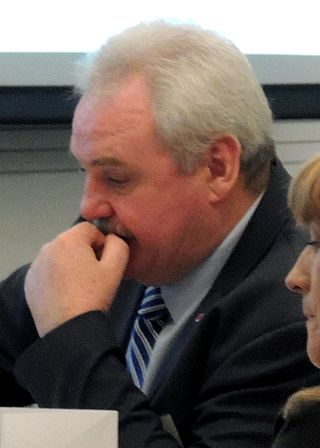
Adrian Stephen Pederick is an Australian politician, representing the South Australian House of Assembly seat of Hammond for the South Australian Division of the Liberal Party of Australia. Pederick currently holds title of the Government Whip in the South Australian House of Assembly.

The southern bluefin tuna is a tuna of the family Scombridae found in open southern Hemisphere waters of all the world's oceans mainly between 30°S and 50°S, to nearly 60°S. At up to 2.5 metres and weighing up to 260 kilograms (570 lb), it is among the larger bony fishes.

The environmental impact of fishing includes issues such as the availability of fish, overfishing, fisheries, and fisheries management; as well as the impact of industrial fishing on other elements of the environment, such as bycatch. These issues are part of marine conservation, and are addressed in fisheries science programs. According to a 2019 FAO report, global production of fish, crustaceans, molluscs and other aquatic animals has continued to grow and reached 172.6 million tonnes in 2017, with an increase of 4.1 percent compared with 2016. There is a growing gap between the supply of fish and demand, due in part to world population growth.
A drum line is an unmanned aquatic trap used to lure and capture large sharks using baited hooks. They are typically deployed near popular swimming beaches with the intention of reducing the number of sharks in the vicinity and therefore the probability of shark attack. Drum lines are often used in association with shark nets, which results in shark mortality. However SMART drum lines can be used to move sharks, which greatly reduces shark and bycatch mortality. The use of drum lines has been successful in reducing shark attacks in the areas where they are installed. The topic of shark culling became an international controversy and sparked public demonstrations and vocal opposition, particularly from environmentalists, animal welfare advocates and ocean activists.

The Sea Shepherd Conservation Society engages in various demonstrations, campaigns, and tactical operations at sea and elsewhere, including conventional protests and direct actions to protect marine wildlife. Sea Shepherd operations have included interdiction against commercial fishing, shark poaching and finning, seal hunting and whaling. Many of their activities have been called piracy or terrorism by their targets and by the ICRW. Sea Shepherd says that they have taken more than 4,000 volunteers on operations over a period of 30 years.
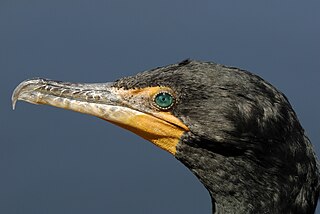
Cormorant culling is the intentional killing of cormorants by humans for the purposes of wildlife management. It has been practiced for centuries, with supporters of culling generally arising from the angling community. Culling techniques may involve the killing of birds, the destruction of eggs, or both. Historically, culls have occurred to protect the interests of recreational and commercial fishermen who perceive the animals to be competing with them for their intended catch or for the prey of their intended catch. Since the 1960s, the growing aquaculture industry has undertaken cormorant culls to protect its farmed fish and crustacean stocks. Opponents of cormorant culling include conservation groups such as the National Audubon Society, Cormorant Defenders International and Sea Shepherd.
Brian Jeffriess is the primary spokesperson for Australia's Southern bluefin tuna fishing and aquaculture industry. He lives in Port Lincoln, South Australia and is the chief executive for the Australian Southern Bluefin Tuna Industry Association. He is a current member of the Australian Maritime and Fisheries Academy, the Commonwealth Fisheries Association, the Aquaculture Advisory Committee and the Fisheries and Aquaculture Research Advisory Committee. Jeffriess features regularly in the Port Lincoln Times newspaper, where he relates the industry's activities and interests to his local community. He attends the international Commission for the Conservation of Southern Bluefin Tuna meetings and works closely with industry and government. On 26 January 2012 Jeffriess was awarded Member of the Order of Australia "for service to the fishing and aquaculture industries as a contributor to the sustainable management and harvesting of Australian fisheries and through national and international professional associations." He has also been awarded State and National Seafood Icon status.

Shark culling is the deliberate killing of sharks by government authorities, usually in response to one or more shark attacks. The term "shark control" is often used by governments when referring to culls. Shark culling has been criticized by environmentalists, conservationists and animal welfare advocates—they say killing sharks harms the marine ecosystem and is unethical. Government officials often cite public safety as a reason for culling. The impact of culling is also minor compared to bycatch with 50 million sharks caught each year by the commercial fishing industry.
Clean Seas Seafood Ltd is an Australian seafood production company specialising in the sea-cage aquaculture of Yellowtail kingfish. It was established by The Stehr Group in 2000, and became the first Australian company fish farming in South Australia to be listed on the ASX in 2005. The company was established by "tuna baron" Hagen Stehr, whose son Marcus remains one of the company's directors. Clean Seas has shore and sea-based fish farming facilities at Arno Bay, aquaculture leases in Fitzgerald Bay and near Port Lincoln and a processing facility at Royal Park in Adelaide. Its tuna interests were originally held by the private company Australian Tuna Fisheries Pty Ltd. Clean Seas' ambition to control and commercialise the lifecycle of the Southern bluefin tuna has not been realised.
Fish farming is a major economic contributor to South Australia's seafood sector. The most valuable species is the Southern bluefin tuna, which is caught in the wild then transferred into sea cages in southern Spencer Gulf where they are fed locally caught sardines. The second most valuable species is the Yellowtail kingfish, which is farmed near Port Lincoln and Arno Bay. A tourist venture called Oceanic Victor located in Encounter Bay allows paying customers the opportunity to swim in a sea cage with the Southern bluefin tuna and handfeed the fish. Prominent companies in the fish farming sector in South Australia include Clean Seas and Tony's Tuna International.
